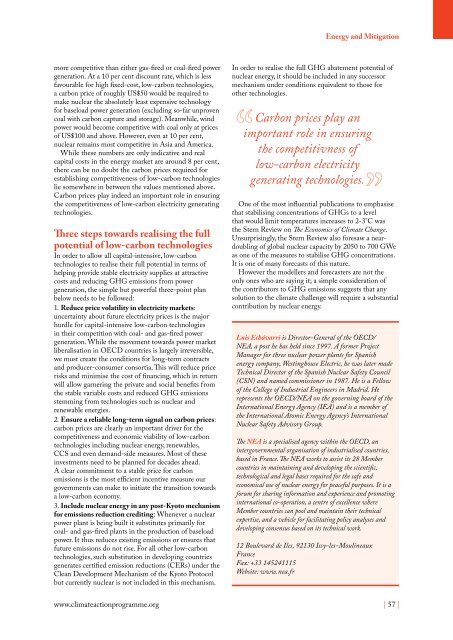Climate Action 2010-2011
You also want an ePaper? Increase the reach of your titles
YUMPU automatically turns print PDFs into web optimized ePapers that Google loves.
Energy and Mitigation<br />
more competitive than either gas-fired or coal-fired power<br />
generation. At a 10 per cent discount rate, which is less<br />
favourable for high fixed-cost, low-carbon technologies,<br />
a carbon price of roughly US$50 would be required to<br />
make nuclear the absolutely least expensive technology<br />
for baseload power generation (excluding so-far unproven<br />
coal with carbon capture and storage). Meanwhile, wind<br />
power would become competitive with coal only at prices<br />
of US$100 and above. However, even at 10 per cent,<br />
nuclear remains most competitive in Asia and America.<br />
While these numbers are only indicative and real<br />
capital costs in the energy market are around 8 per cent,<br />
there can be no doubt the carbon prices required for<br />
establishing competitiveness of low-carbon technologies<br />
lie somewhere in between the values mentioned above.<br />
Carbon prices play indeed an important role in ensuring<br />
the competitiveness of low-carbon electricity generating<br />
technologies.<br />
Three steps towards realising the full<br />
potential of low-carbon technologies<br />
In order to allow all capital-intensive, low-carbon<br />
technologies to realise their full potential in terms of<br />
helping provide stable electricity supplies at attractive<br />
costs and reducing GHG emissions from power<br />
generation, the simple but powerful three-point plan<br />
below needs to be followed:<br />
1. Reduce price volatility in electricity markets:<br />
uncertainty about future electricity prices is the major<br />
hurdle for capital-intensive low-carbon technologies<br />
in their competition with coal- and gas-fired power<br />
generation. While the movement towards power market<br />
liberalisation in OECD countries is largely irreversible,<br />
we must create the conditions for long-term contracts<br />
and producer-consumer consortia. This will reduce price<br />
risks and minimise the cost of financing, which in return<br />
will allow garnering the private and social benefits from<br />
the stable variable costs and reduced GHG emissions<br />
stemming from technologies such as nuclear and<br />
renewable energies.<br />
2. Ensure a reliable long-term signal on carbon prices:<br />
carbon prices are clearly an important driver for the<br />
competitiveness and economic viability of low-carbon<br />
technologies including nuclear energy, renewables,<br />
CCS and even demand-side measures. Most of these<br />
investments need to be planned for decades ahead.<br />
A clear commitment to a stable price for carbon<br />
emissions is the most efficient incentive measure our<br />
governments can make to initiate the transition towards<br />
a low-carbon economy.<br />
3. Include nuclear energy in any post-Kyoto mechanism<br />
for emissions reduction crediting: Whenever a nuclear<br />
power plant is being built it substitutes primarily for<br />
coal- and gas-fired plants in the production of baseload<br />
power. It thus reduces existing emissions or ensures that<br />
future emissions do not rise. For all other low-carbon<br />
technologies, such substitution in developing countries<br />
generates certified emission reductions (CERs) under the<br />
Clean Development Mechanism of the Kyoto Protocol<br />
but currently nuclear is not included in this mechanism.<br />
In order to realise the full GHG abatement potential of<br />
nuclear energy, it should be included in any successor<br />
mechanism under conditions equivalent to those for<br />
other technologies.<br />
Carbon prices play an<br />
important role in ensuring<br />
the competitivness of<br />
low-carbon electricity<br />
generating technologies.<br />
One of the most influential publications to emphasise<br />
that stabilising concentrations of GHGs to a level<br />
that would limit temperatures increases to 2-3°C was<br />
the Stern Review on The Economics of <strong>Climate</strong> Change.<br />
Unsurprisingly, the Stern Review also foresaw a neardoubling<br />
of global nuclear capacity by 2050 to 700 GWe<br />
as one of the measures to stabilise GHG concentrations.<br />
It is one of many forecasts of this nature.<br />
However the modellers and forecasters are not the<br />
only ones who are saying it; a simple consideration of<br />
the contributors to GHG emissions suggests that any<br />
solution to the climate challenge will require a substantial<br />
contribution by nuclear energy.<br />
Luis Echávarri is Director-General of the OECD/<br />
NEA, a post he has held since 1997. A former Project<br />
Manager for three nuclear power plants for Spanish<br />
energy company, Westinghouse Electric, he was later made<br />
Technical Director of the Spanish Nuclear Safety Council<br />
(CSN) and named commissioner in 1987. He is a Fellow<br />
of the College of Industrial Engineers in Madrid. He<br />
represents the OECD/NEA on the governing board of the<br />
International Energy Agency (IEA) and is a member of<br />
the International Atomic Energy Agency’s International<br />
Nuclear Safety Advisory Group.<br />
The NEA is a specialised agency within the OECD, an<br />
intergovernmental organisation of industrialised countries,<br />
based in France. The NEA works to assist its 28 Member<br />
countries in maintaining and developing the scientific,<br />
technological and legal bases required for the safe and<br />
economical use of nuclear energy for peaceful purposes. It is a<br />
forum for sharing information and experience and promoting<br />
international co-operation, a centre of excellence where<br />
Member countries can pool and maintain their technical<br />
expertise, and a vehicle for facilitating policy analyses and<br />
developing consensus based on its technical work.<br />
12 Boulevard de Iles, 92130 Issy-les-Moulineaux<br />
France<br />
Fax: +33 145241115<br />
Website: www.nea.fr<br />
www.climateactionprogramme.org | 57 |












